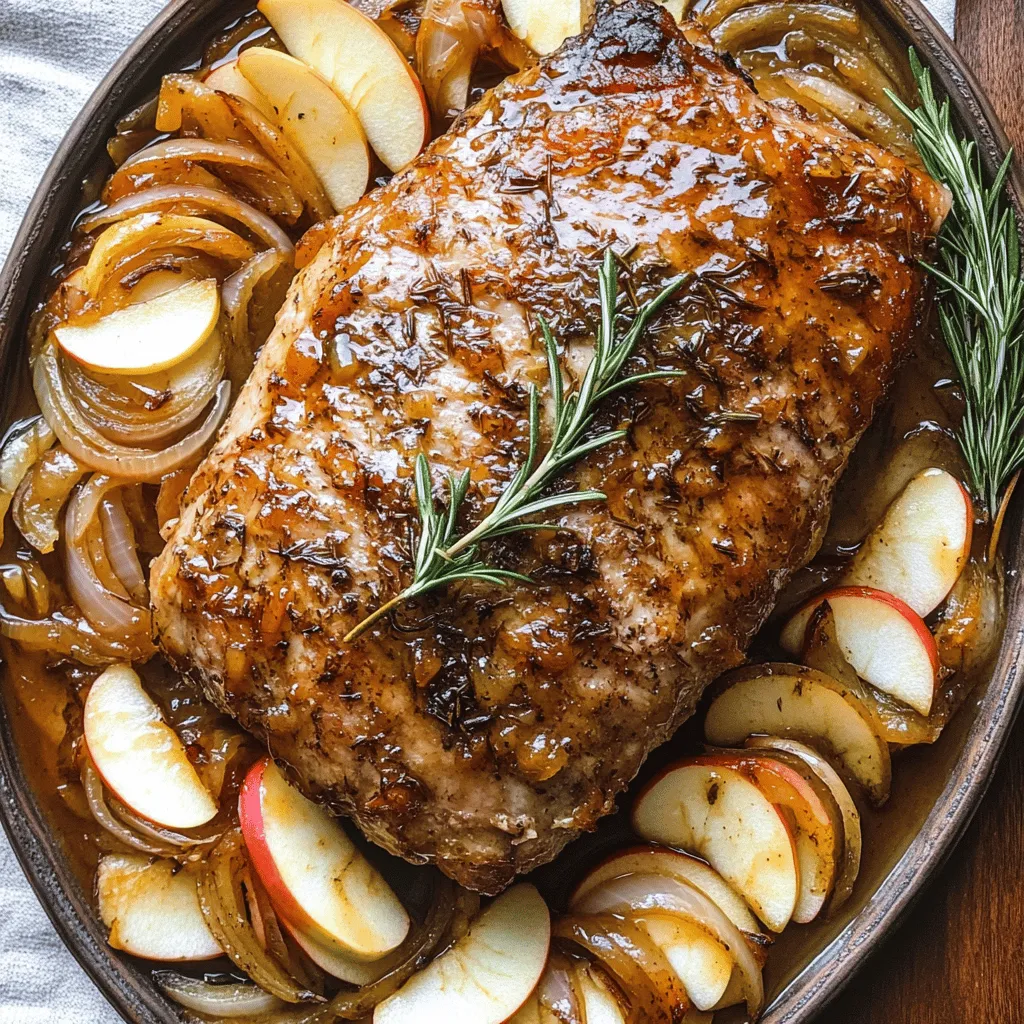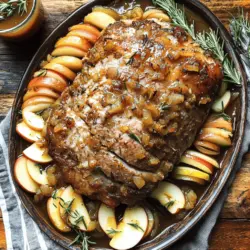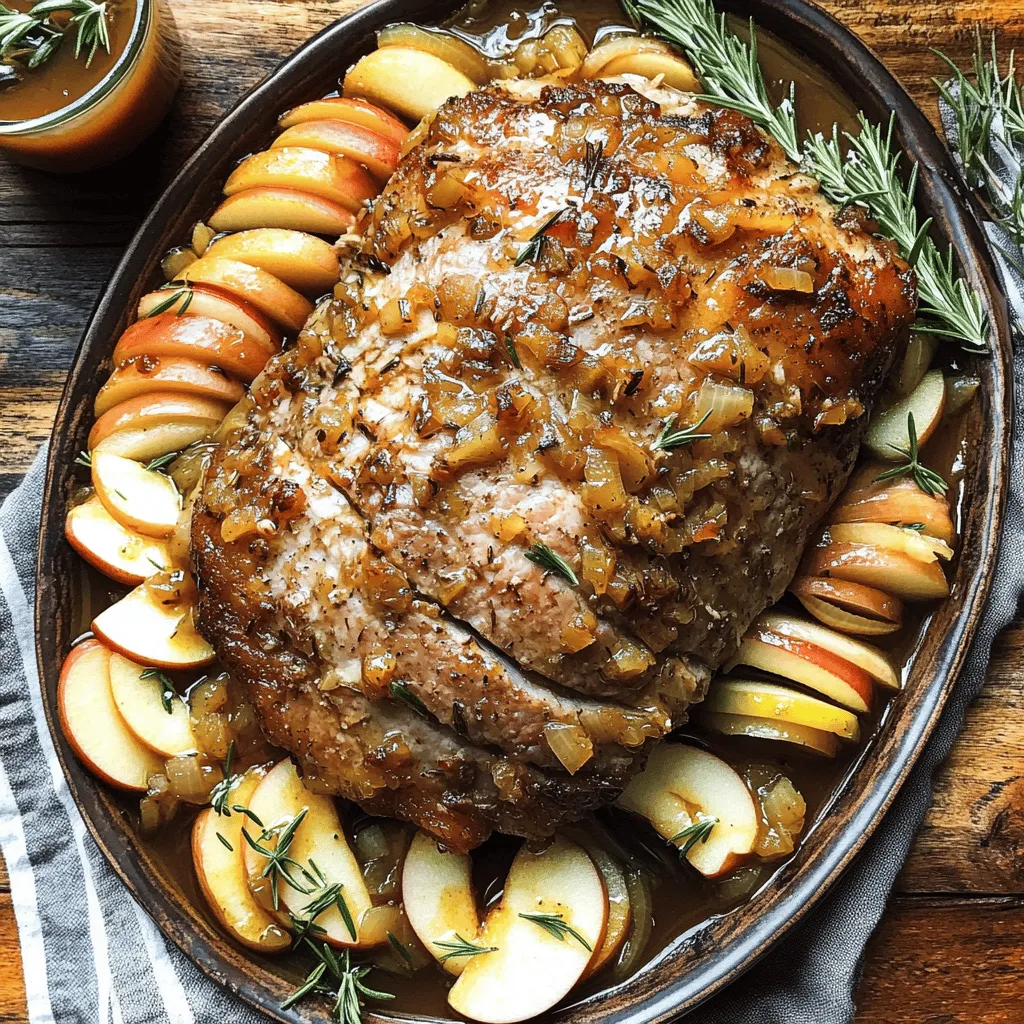Looking to impress at your next dinner? My Slow-Cooked Pork Shoulder with Apple Cider Delight is your ticket to a mouthwatering meal! With tender meat, rich flavors, and a hint of sweetness, this dish will have everyone coming back for more. In this article, I’ll guide you through each step, from choosing ingredients to perfecting cooking methods. Let’s dive in and make a meal that delights everyone at your table!
Ingredients
Main Ingredients
- 3-4 lbs pork shoulder, bone-in
- 2 cups apple cider (non-alcoholic)
- 1 large onion, sliced
Seasonings and Additional Flavorings
- 4 cloves garlic, minced
- 2 tablespoons brown sugar
- 2 tablespoons apple cider vinegar
- 2 teaspoons ground cinnamon
- 1 teaspoon ground nutmeg
- 1 teaspoon salt
- 1 teaspoon black pepper
- 1 tablespoon olive oil
Garnishing Elements
- 2-3 apples (such as Granny Smith or Honeycrisp), cored and sliced
- Fresh rosemary sprigs for garnish
To make Slow-Cooked Pork Shoulder with Apple Cider, you need quality ingredients. Start with a pork shoulder. This cut has a good amount of fat, which helps it stay juicy. The apple cider adds sweetness and balance. Use a large onion for depth of flavor.
For seasonings, you’ll want garlic for a savory kick. Brown sugar adds a hint of caramel. Apple cider vinegar brings acidity, which brightens the dish. Ground cinnamon and nutmeg give warmth and spice. Salt and black pepper enhance all the flavors. Olive oil helps with browning the meat.
For garnishing, fresh apples add texture and taste. Rosemary gives a lovely aroma and color. These ingredients make the dish hearty and delightful.Now, gather all these items, and let’s cook!
Step-by-Step Instructions
Preparation Steps
- Trim excess fat from the pork shoulder and season.
- Pat dry and apply salt, pepper, cinnamon, and nutmeg.
Start by preparing the pork shoulder. Trimming the fat helps reduce greasiness. Once trimmed, pat the meat dry with paper towels. This step ensures the seasonings stick well. Season all over with salt, black pepper, ground cinnamon, and ground nutmeg. These spices add warmth and depth to the dish.
Cooking Process
- Sear the pork shoulder in a skillet.
- Transfer to the slow cooker.
Next, heat olive oil in a large skillet over medium-high heat. When the oil is hot, add the seasoned pork shoulder. Sear it for about 4-5 minutes on each side until it turns a lovely brown color. This browning gives the meat a rich flavor. After searing, move the pork shoulder to the slow cooker.
Sauce Creation
- Sauté onions, then add garlic.
- Mix apple cider ingredients and pour over the pork.
In the same skillet, lower the heat to medium. Add the sliced onion and sauté for about 3-4 minutes, until soft. Then, add minced garlic and cook for another minute. This process releases sweet flavors. In a bowl, mix apple cider, apple cider vinegar, and brown sugar. Pour this mix over the sautéed onions and garlic. Make sure to scrape up any tasty bits stuck to the skillet. These bits will deepen the sauce’s flavor.
Slow Cooking Method
- Cook on low for 8-10 hours or high for 4-5 hours.
- Rest the pork before shredding.
Now, pour the apple and onion mixture over the pork shoulder in the slow cooker. Cover it and set the cooker to low for 8-10 hours or high for 4-5 hours. The long cooking time makes the pork tender. Once cooked, take the pork out and let it rest for 10-15 minutes before shredding. Resting allows the juices to settle, keeping the meat moist.
Final Presentation
- Serve with cooked apples and onions.
- Spoon over apple cider sauce.
When ready to serve, plate the shredded pork shoulder with the cooked apples and onions. Spoon the apple cider sauce over the top. For an extra touch, garnish with fresh rosemary sprigs. This dish pairs well with creamy mashed potatoes or rustic bread. Enjoy the delightful flavors of your slow-cooked pork shoulder with apple cider!
Tips & Tricks
Professional Cooking Advice
Searing the meat is key. It adds flavor and color. Heat oil in a skillet, and brown all sides for about 4-5 minutes. This step makes your pork shoulder taste rich and deep.
Resting the pork is just as important. After cooking, let the pork sit for 10-15 minutes. This allows juices to spread evenly. You want every bite to be juicy and tender.
Flavor Enhancements
Try adding more seasonings. A pinch of smoked paprika adds a nice touch. You can also use a little cayenne for heat. Consider fresh herbs like thyme or sage for extra flavor.
Pair your pork with sides that complement it well. Creamy mashed potatoes work great. A fresh salad or roasted vegetables add color and balance to your plate.
Common Mistakes to Avoid
Avoid overcooking the pork. It can turn dry and tough. Check your slow cooker settings. Cooking on low for 8-10 hours is best.
Do not skip resting the meat. If you cut it right away, juices will run out. Letting it rest keeps the pork moist and delicious.

Variations
Ingredient Swaps
- Alternative meats to use: You can swap pork shoulder for beef chuck or chicken thighs. Both options bring a different taste. Beef offers a rich flavor, while chicken cooks faster and stays moist.
- Non-cider liquids for a different flavor profile: Try using chicken broth or white wine instead of apple cider. These liquids add a new twist. They can bring out different flavors in your dish.
Cooking Technique Variations
- Instant Pot method for quicker preparation: If time is short, use an Instant Pot. Sear the pork, add your liquids, then cook on high for about 60 minutes. This method keeps the meat tender and saves you hours.
- Oven roasting approach: You can also roast the pork in the oven. After searing, place it in a deep baking dish with the apple cider mix and cover it tightly. Roast at 300°F for 4-5 hours. This method gives a nice caramelization.
Serving Suggestions
- Pairing with different vegetable sides: Serve the pork with roasted Brussels sprouts or steamed green beans. Both veggies add color and balance to the meal. You can also try mashed sweet potatoes for a sweeter flavor.
- Creative uses for leftovers: Use leftover pork in tacos or sandwiches. You can also mix it into a salad for a hearty lunch. The flavors only get better the next day!
Storage Info
Refrigeration Tips
To store leftovers, let the pork cool first. Place it in an airtight container. You can also use a resealable bag. Store it in the fridge for up to three days. Always label the container with the date. This helps you keep track of freshness.
Freezing Instructions
To freeze cooked pork shoulder, first slice or shred it. Place it in a freezer-safe bag. Remove as much air as possible before sealing. You can keep it in the freezer for up to three months. Be sure to label the bag with the date.
Reheating Guidelines
To reheat, use a microwave or oven. If using a microwave, heat it on medium power. Stir halfway through for even warming. If using an oven, preheat it to 350°F (175°C). Cover the pork with foil to keep it moist. Heat until it reaches 165°F (74°C). This ensures you keep all the flavors intact.
FAQs
What can I serve with Slow-Cooked Pork Shoulder with Apple Cider?
You can serve many tasty sides with this dish. Here are some great ideas:
- Creamy mashed potatoes
- Roasted vegetables like carrots and Brussels sprouts
- Warm, crusty bread
- A fresh green salad with tangy dressing
- Coleslaw for a crunchy contrast
These sides balance the rich flavors of the pork and apple cider. They will make your meal feel complete and satisfying.
Can I use other types of pork?
Yes, you can use other cuts of pork. Here are some options:
- Pork loin for a leaner choice
- Pork butt, which is similar to shoulder
- Pork ribs for a different texture
Each cut will give you a unique taste and texture. Adjust cooking times based on the cut you choose.
How do I know when the pork is done?
To check if your pork is done, look for these signs:
- The meat should be fork-tender and easily pull apart
- Internal temperature should reach 195°F to 205°F
Using a meat thermometer will help ensure perfect doneness. If it isn’t tender, give it more time in the slow cooker.
Is it necessary to brown the meat?
Browning the meat is not required, but it has many benefits:
- It adds a rich flavor to the meat
- It creates a nice color on the outside
- It enhances the overall taste of the dish
Searing helps to lock in juices and adds depth to your meal. It only takes a few minutes, and it is worth the effort.
How long do leftovers last in the fridge?
Cooked pork shoulder can last in the fridge for about 3 to 4 days. Store it in an airtight container to keep it fresh. Make sure to let it cool before sealing. If you want to keep it longer, consider freezing it.
This blog post covered how to make a delicious slow-cooked pork shoulder with apple cider. We discussed key ingredients, seasonings, and the cooking process. I shared valuable tips and tricks to avoid common mistakes and offered variations to explore. Proper storage and reheating guidelines ensure your dish stays tasty.
In conclusion, you can create a flavorful meal with these simple steps. Enjoy every bite, and feel free to get creative with your ingredients. Your next family dinner just got a whole lot better!


